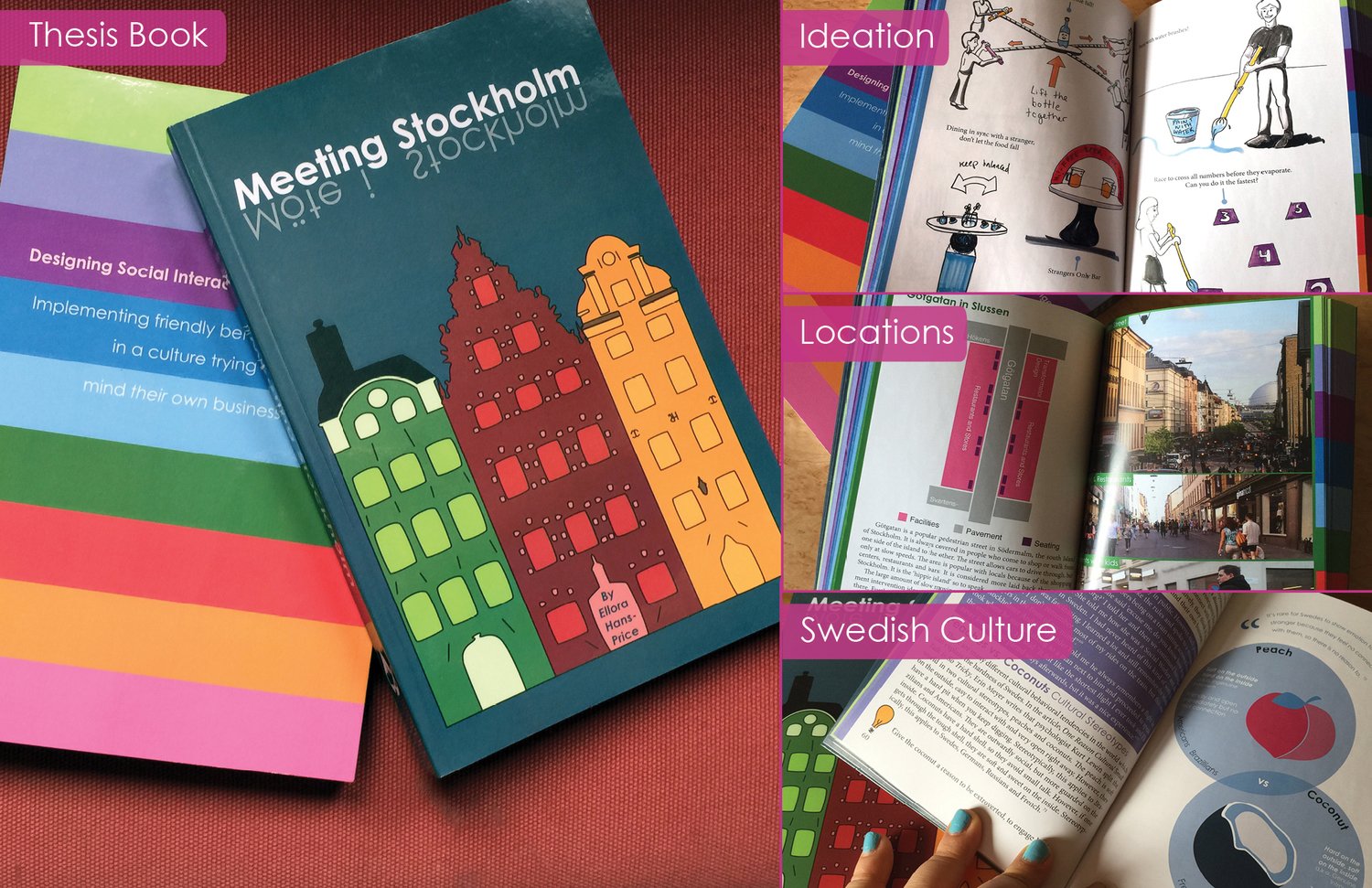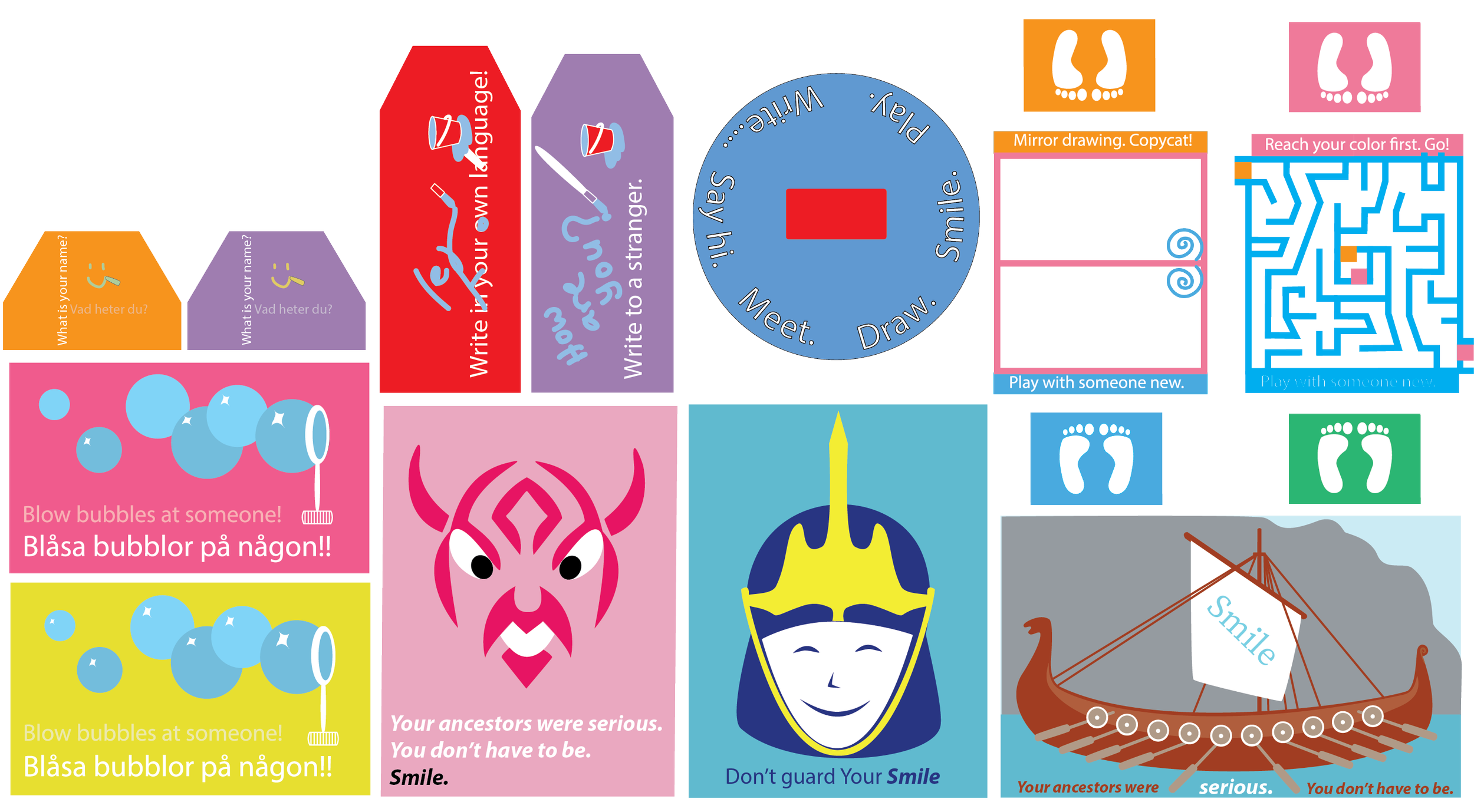Meeting Stockholm / Master’s Thesis
{Service Design, Design Research, Design Strategy, Design Process Development}
Designing ways to engage Swedish strangers in public areas of the city & encourage positive interaction with strangers.
Master's Thesis: Designing ways to encourage stranger interaction in Stockholm, Sweden.
The solution is CityStrokes: a service that stages games, facilitated by large water brushes and games, throughout the city, to entice strangers to interact through shared, competitive experiences. The most effective game is pictured below: A maze designed for three people who must race to the center. Three long, colored sentences lead up to the maze and prompt people to play with strangers: "Swedes don't smile at strangers so try playing."
My Design Process
My process is a marriage of service design and product design. I designed it for deep ethnographic research and contextual inquiry as well as a series of prototyping to find the best solution. This helped me identified opportunities for a great service to allow strangers to interact using touch points designed to facilitate the service.
Swedish Culture vs. Other Cultures
Swedes have a culture where they aren’t friendly to strangers and like their personal space. Through research and cultural immersion I discovered that they were hardened on the outside but sweet and open on the inside, like a coconut.
Swedish Personal Space
*This was measured using a measuring tape during contextual inquiry.
Swedish cultural rules make them unfriendly to strangers and people like personal space. In order for my design to work, I needed to know what distance was comfortable during interaction. I went out and asked Swedes to let measure their personal space with a measuring tape.
“Swedes are like cats, you can’t approach them, they will run away.
They must come to you.”
-Swedish Interviewee-
In order to get Swedes to interact, they must be curious enough to come over and try something new. It should be their idea to get involved. There should also be a 3 feet between faces.
Analyzing Meetings
While researching in Sweden, I realized Swedish people have the same friendly greeting as I was used to: a hug. Through contextual research, I discovered it was widely considered the most friendly greeting between strangers. To show how unusual this was, I followed up with a wide survey about greetings in European countries as well as the USA, The UK and Austrailia.
Design Strategy
Create a Swedish-friendly ice-breaker that gets people’s attention in public and is enticing enough to disrupt the unspoken social rule of not talking to strangers. It must be an interaction that is inviting and fun and doesn’t feel like an imposition.
Solution Tactics
The Customer Journey was created based on all of the design research. It was used as a measurement of success for the prototypes. The ideal solution would take 2 or more strangers through the entire journey. The goal was to create awareness and get people to participate and meet a stranger.
Public Prototypes
I set up and monitored 6 prototypes. The first five were successful in some way but did not complete the customer journey. The element of play (utilized in numbers 2, 4, 5 and 6, garnered the most interactions. When the element of a camera was involved, Swedes got curious and wanted to be photographed. When competition was involved, the prototypes had the longest use and the most attention.
For each prototype, I counted participants and interviewed and interacted with many. The key challenge/ insight was getting strangers to engage with someone other than me or their friends.
#1 Smile Walk
Design: Ground signage asking strangers to smile at someone as they walked by.
Discovery: Swedes will read words on the ground and are curious enough to find the next one but need more direction.
#2 Playful Steps
DESIGN: Creating a playful area with recognizable toys like chalk and slinkies. It encouraged people to stop and meet someone while doing something creative.
DISCOVERY: People engaged with the prototype and me, but not with anyone else new.
#3 Smile Challenge
DESIGN: Grounded signage asking swedes to smile at a smile target or an oncoming stranger.
DISCOVERY: This was the first prototype to engage strangers. It worked best when I stood on the the sign or someone else did. Swedes love posing for the camera without being asked. People still didn’t engage with each other without extra intervention.
#4 Water Brush Freeplay
DESIGN: This expanded on the success of play elements in #2. I prototyped large water brushes to draw on cement with and encourage passersby to play.
DISCOVERY: Many people enjoyed playing with the brushes but the only stranger interaction was looking to observe other people.
#5 Waterbrush Games
DESIGN: Puzzles and games on the ground (a 2-way maze and tic-tac-toe) that could be completed with water brushes.
DISCOVERY: People engaged with both games, usually in succession. However, people played with people they were already walking with. I observed that people mostly walked in twos so set out to design a larger scale game with 3 players needed.
Successful Prototype
Design: 3-way maze encouraging 2 friends to invite a stranger to play with them and race to the middle. The prototype consistently brought Swedish strangers all the way through the intended customer journey.
Why It Works
CityStrokes
The research culminated in a service design, placed throughout cities in the summer months, to creates pop-up installations to encourage positive, stranger interaction.
The service has 4 main components:




















